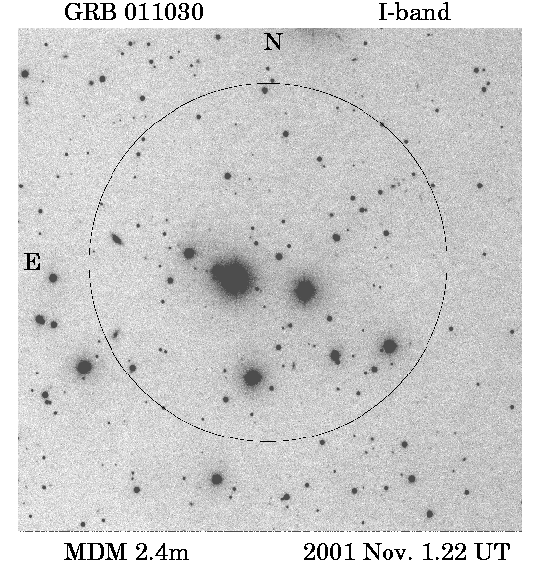|
|
|
|
| GRB 011030: Search for IR Afterglow |
| (BeppoSAX 2.1 arcmin radius error circle) |
 |
| GCN Circular #1126: GRB 011030 K-band Observations |
Molly Hammell (Dartmouth), J. P. Halpern, & N. Mirabal (Columbia U.) report on behalf of the MDM Observatory GRB follow-up team: "Using the MDM 1.3m, we obtained 120 minutes of exposure in the K band centered at Oct. 31.11 UT, 20 hours after the burst. All of the 2.1' radius refined BeppoSAX error circle (in 't Zand et al., GCN #1123) was covered. A follow-up observation was performed on Nov. 1.20 UT, with 40 minutes of exposure. Conditions were not photometric, and these images have not been calibrated. However, no afterglow candidate has been found to an approximate limiting magnitude K > 18. Additional observations on Nov. 1 covering the position of the radio source VLA J2042+7718 reported by Taylor et al. (GCN #1122) reveal no detection to a slightly deeper limiting magnitude. A prominent galaxy is seen at the position of the radio source VLA J2044+7717 (see also Rol et al., GCN #1124). It is constant to better than 0.05 mag. I-band images were also obtained on both nights using the MDM 2.4m. Results of these will be reported subsequently. A K-band image is posted at http://www.astro.columbia.edu/~jules/grb/011030 This message may be cited." |
GRB 011030: Search for I-band Afterglow
 |
| GCN Circular #1127: GRB 011030 I-band Observations |
J. P. Halpern, N. Mirabal (Columbia), Chris Burke, & D. L. DePoy (Ohio State), report on behalf of the MDM Observatory GRB follow-up team: "Using the MDM 2.4m, we obtained 15 minutes of exposure in the I band centered at Oct. 31.21 UT, 22.5 hours after the burst. All of the 2.1' radius refined BeppoSAX error circle (in 't Zand et al., GCN #1123) was covered. A follow-up observation was performed on Nov. 1.22 UT, with 15 minutes of exposure. Conditions were not photometric, and these images have not been calibrated. However, no afterglow candidate has been found to a limit approximately 1 mag fainter than the POSS-II IVN plate, or I_c > 20.5. An I-band image is posted at http://www.astro.columbia.edu/~jules/grb/011030 This message may be cited." |
GRB 011030: Search at Radio Position
 |
| GCN Circular #1139: GRB 011030 I-band Observation |
J. P. Halpern, N. Mirabal (Columbia), C. Burke, D. L. DePoy (Ohio State), & S. Gaudi (IAS), report on behalf of the MDM Observatory GRB follow-up team: "Using the MDM 2.4m, we reobserved this location in the I band on Nov. 9.23 UT. In two 8 minute exposures in seeing of 1.2 arcseconds, there is a possible detection at the 2 sigma level of an object at position (J2000) 20:43:31.94, +77:17:19.0, which is 1.2 arcseconds west of the position reported for the new radio source that appeared on Nov 8.80 (Taylor et al. GCN #1136). Assuming for a calibration that the faintest objects on the POSS-II IVN plates have I=19.5, this possible counterpart would have I=22.5. Given the marginal level of this detection and its absence on previous images of comparable depth on Nov. 1, confirmation would be required. Alternatively, this may be considered an upper limit to the optical brightness of the radio source. The new image is posted at http://www.astro.columbia.edu/~jules/grb/011030 This message may be cited." |
|
Molly Hammell Molly.C.Hammell@Dartmouth.edu |
Jules Halpern jules@astro.columbia.edu |
Nestor Mirabal abulafia@astro.columbia.edu |
|
Chris Burke cjburke@astronomy.ohio-state.edu |
Darren DePoy depoy@astronomy.ohio-state.edu |
| Dartmouth College, Columbia University, Ohio State University and MDM Observatory |
